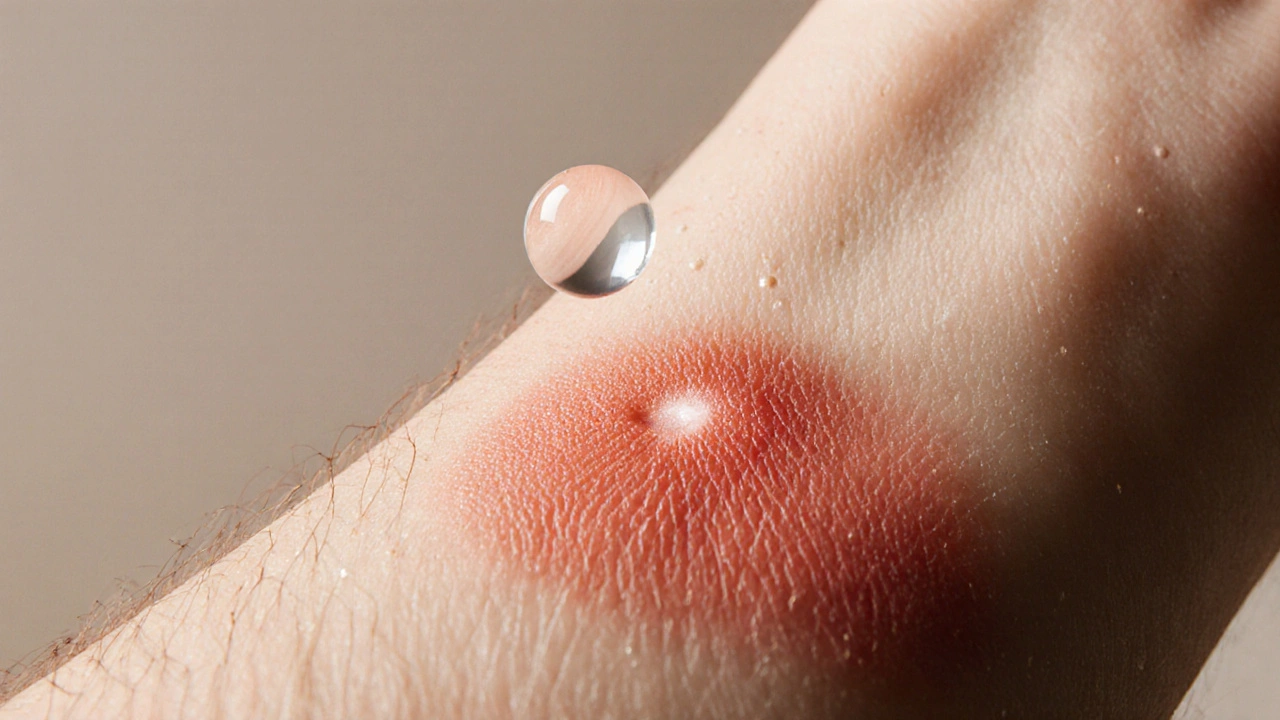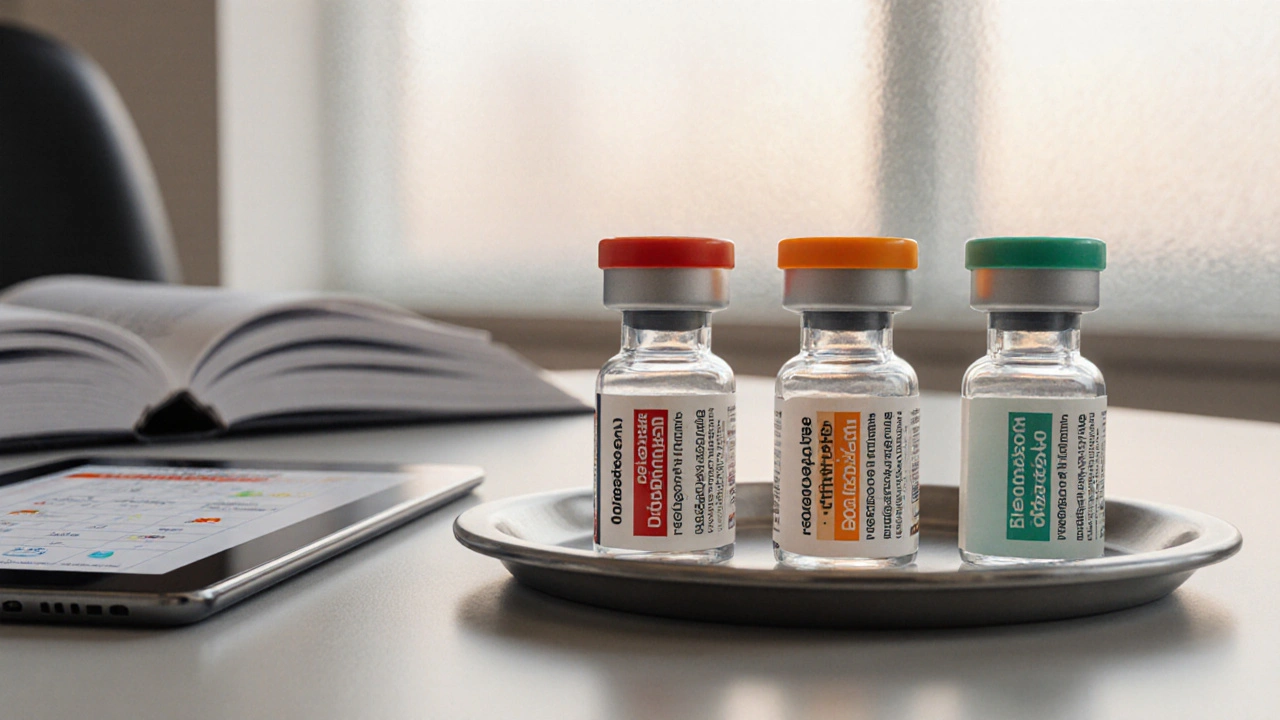Tenovate vs. Topical Steroid Alternatives Comparison Tool
Compare Topical Steroid Potency
Select two products to compare their key characteristics.
Comparison Results
Potency Classes Explained
Super-potent
Most potent. Used for severe conditions only.
High-potency
Effective for chronic conditions on larger areas.
Mid-potency
Good balance of efficacy and safety.
Mild-potency
Safest for long-term use on sensitive areas.
When you need a fast‑acting solution for stubborn psoriasis or severe eczema, Tenovate is a brand name for clobetasol propionate, a classI (super‑potent) topical corticosteroid. It’s the go‑to for dermatologists when other creams just aren’t cutting it. But is it always the best pick? Let’s break down how Tenovate stacks up against the most common alternatives you’ll see on a pharmacy shelf.
Why potency matters
Topical steroids are grouped into four potency classes in the U.S. - classI (super‑potent) down to classIV (mild). The higher the class, the stronger the anti‑inflammatory effect, but also the higher the risk of skin thinning, steroid‑induced rosacea, and systemic absorption. The FDA requires manufacturers to list the active ingredient, strength, and intended use, which helps clinicians match the right strength to the right condition.
How Tenovate works
Clobetasol propionate binds to glucocorticoid receptors in skin cells, shutting down cytokine production and reducing immune‑mediated inflammation. Its 0.05% concentration delivers a rapid drop in redness, scaling, and itching - often within a few days. Because it’s super‑potent, doctors usually prescribe it for short bursts (2‑4weeks) on limited body areas.
Topical steroid alternatives
Below are the most frequently considered substitutes. Each has its own potency tier, typical uses, and safety profile.
- Betamethasone dipropionate is a classII (high‑potency) steroid often used for chronic eczema and psoriasis on larger surface areas.
- Halobetasol propionate matches Tenovate in potency (classI) but is formulated as a lotion, making it a bit easier to spread on hairy or irregular skin.
- Mometasone furoate sits in classIII (mid‑potency) and is a popular choice for scalp psoriasis and atopic dermatitis.
- Triamcinolone acetonide is a classIII steroid widely available as a cream or ointment for mild‑to‑moderate inflammation.
- Hydrocortisone is the mildest (classIV) steroid, safe for daily use on sensitive areas like the face or intertriginous zones.
- Tacrolimus is a calcineurin inhibitor, not a steroid at all. It’s useful for steroid‑phobia patients and works well on chronic eczema without causing skin thinning.

Side‑by‑side comparison
| Product | Potency Class | Typical Indications | Maximum Recommended Duration | Common Side Effects |
|---|---|---|---|---|
| Tenovate (Clobetasol) | I (Super‑potent) | Severe plaque psoriasis, dyskeratotic eczema, lichen planus | 2‑4weeks on <10% BSA | Skin atrophy, telangiectasia, systemic cortisol suppression |
| Betamethasone dipropionate | II (High‑potency) | Chronic eczema, moderate‑severe psoriasis | 4‑6weeks on <20% BSA | Mild thinning, stretch marks |
| Halobetasol propionate | I (Super‑potent) | Psoriasis, vitiligo, hypertrophic scars | 2‑4weeks on <15% BSA | Similar to Tenovate, but slightly lower systemic absorption |
| Mometasone furoate | III (Mid‑potency) | Scalp psoriasis, atopic dermatitis | 8‑12weeks on <30% BSA | Occasional burning, minimal atrophy |
| Tacrolimus | - (Non‑steroid) | Chronic eczema, steroid‑sensitive areas | Indefinite, as needed | Transient burning, rare lymphoma risk (theoretical) |
Choosing the right product - a quick decision guide
Think of the decision like a traffic light:
- Red - severe, localized disease: Tenovate or Halobetasol for a short, aggressive push.
- Yellow - moderate disease covering larger areas: Betamethasone dipropionate or Mometasone, which give strong relief without the highest risk profile.
- Green - mild or chronic conditions: Hydrocortisone for everyday maintenance, or Tacrolimus if you or your patient wants to avoid steroids altogether.
Always ask a dermatologist before starting a classI steroid, especially on sensitive skin like the face, folds, or in children.
Safety tips and best practices
- Apply a thin layer - more isn’t better.
- Limit use to the prescribed time frame; a “just one more week” habit can lead to irreversible thinning.
- Rotate sites if you need to treat multiple patches; give each area a break of at least two weeks.
- Watch for signs of systemic absorption: unexplained weight gain, mood swings, or high blood pressure.
- Moisturize after the steroid clears to rebuild the skin barrier.
Frequently Asked Questions
Can I use Tenovate on my face?
Generally no. The facial skin is thin and absorbs steroids quickly, so a classI product like Tenovate can cause noticeable atrophy. For facial eczema, dermatologists usually recommend a low‑potency steroid such as hydrocortisone or a non‑steroidal option like tacrolimus.
How does clobetasol compare to halobetasol?
Both are classI steroids, but halobetasol is often formulated as a lotion or foam, which can feel lighter on the skin. Pharmacokinetic studies from 2023 show halobetasol has a slightly lower systemic cortisol suppression profile, making it a marginally safer pick for larger body‑surface areas.
What’s the biggest risk of long‑term use?
Skin atrophy - the skin becomes thin, fragile, and prone to tearing. Over time you may also see telangiectasia (visible capillaries) and a higher chance of secondary infections.
Are there any non‑steroid alternatives that work as well?
Calcineurin inhibitors like tacrolimus and pimecrolimus provide comparable relief for chronic eczema without causing skin thinning. They’re slower to act, so many clinicians start with a short steroid burst and then switch to a calcineurin inhibitor for maintenance.
How often should I see my dermatologist while using Tenovate?
Check in after 2weeks. If the lesions have improved and there are no adverse effects, you can taper or stop according to the doctor’s plan. Anything longer than 4weeks without a follow‑up raises red flags.

13 Comments
Wow, this tool packs a lot of data, but honestly, the UI feels like a 90‑s brochure, cluttered with tables, dropdowns, and pop‑ups, making it hard to focus on the core differences, especially when you just want a quick glance at potency and side‑effects.
While the comparison is thorough, it fails to stress the ethical responsibility of prescribing super‑potent steroids, which, if misused, can cause irreversible skin atrophy, and that oversight is simply unaccceptable.
It's fascinating how we constantly chase the "strongest" cream, yet we forget that healing is as much about the skin's own resilience as it is about pharmacolgy; perhaps the true art lies in balancing potency with patience.
Oh sure, because slathering on a class‑I steroid is the ultimate solution-who needs lifestyle tweaks or moisturizers when you can just obliterate inflammation with a chemical blitz, right?
I see your point, but it’s worth noting that many patients truly benefit from a short, targeted course of high‑potency therapy, especially when other measures have failed.
From a practical standpoint, the tool helps clinicians match the right steroid to the condition-Tenovate for acute flares, hydrocortisone for maintenance, and tacrolimus when steroid‑phobia is a concern.
Actually, the duration info could use a note about cummulative exposure-repeated short courses can still add up, so monitoring is key.
Indeed, the cumulative effect underscores the philosophy that medicine is a marathon, not a sprint; sustainable management beats quick fixes every time.
Think of it like a spice rack: Tenovate is the hot sauce for severe eruptions, while hydrocortisone is the mild seasoning you can sprinkle daily without burning the skin.
Use the lowest effective strength.
While the table is comprehensive, it neglects to address the pharmacokinetic nuances that differentiate clobetasol's lipophilicity from betamethasone's, a distinction critical for clinicians seeking optimal dermal penetration.
Great tool! It makes picking the right cream feel less intimidating, especially for those new to dermatology.
Keep exploring these comparisons-you’ll soon develop the confidence to tailor treatments that soothe flare‑ups without over‑doing it.
Write a comment